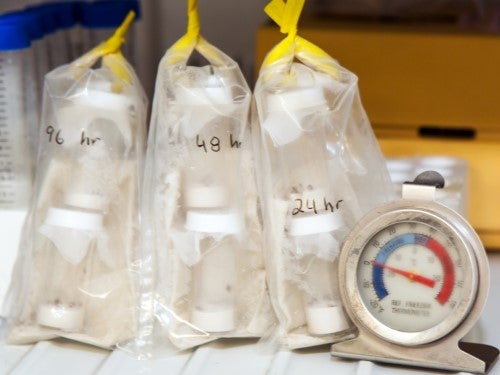Have you been wondering (hoping) if these brutal polar vortex episodes sweeping the eastern half of the nation are freezing the palps off of blacklegged (deer) ticks? It’d be nice, right?
Recently, when we put some adult female deer ticks in our own polar vortex (aka, the freezer), ticks were killed in 24 hours. The temperature was -2°F. It’s certainly been colder than that in Green Bay, Pittsburg and Burlington. So, yea!! Being attacked by fewer ticks come springtime would be some kind of payback for the extreme heating bills of this winter.
But hold on! Outside in nature, the ticks are on the ground, maybe under leaves and snow. And anyway, over evolutionary time, ticks probably have seen their share of frigid polar vortex conditions…and somehow survived them. Besides, like the recent temperatures, our TickSpotters reports have been going up and down like a yo-yo, reminding us that even during a harsh winter, an unexpected tick encounter is always “just a few mild days away.” So, we took more ticks outside to test what would happen (spoiler alert, watch the video and get prepared to be shocked!). In science terms, what we’ve been talking about thus far is a crude assessment of cold hardiness. And gosh darn it, these ticks are cold hardy.
We looked into the literature to find hard data on tick cold hardiness, and actually found surprisingly little information. We did learn that ticks are killed when ice crystals form in their cells, and the lowest temperature just before ice begins to form is called the supercooling point. But, freeze susceptible organisms including ticks may be killed well above their supercooling temperature, at a temperature called their lower lethal temperature.
To avoid freezing, insects and ticks have a few tricks that they use. Some produce extracellular protein ice neucleators, allowing them to begin “freezing” at higher temperatures; this extracellular ice causes an outflux of water from the cells, which then lowers the freezing point at which cell-damaging ice forms inside of cells. That’s smart! Others may produce glycerol or other cryoprotectants but producing those low molecular weight molecules generally requires a conditioning period. Maybe that’s why our ticks died in the freezer—we didn’t give them time to acclimatize!
 The supercooling temperature reported for nymphal deer ticks in one study was -7°F but the lower lethal temperature was reached in a 2 hr exposure to 14°F.¹ Unfortunately, we found no data reported for adult deer ticks but it’s certainly been colder than that, and somehow the ticks survive to bite another day. One clue may come from a study reporting that soil surface temperatures in Minnesota during December 1980 and January 1981 ranged between 21°F and 28°F.¹ Additionally, thanks to both insulation and reflectivity, snow cover can actually keep temperatures at the ground relatively steady and, while not balmy, certainly warm enough for ticks to survive.
The supercooling temperature reported for nymphal deer ticks in one study was -7°F but the lower lethal temperature was reached in a 2 hr exposure to 14°F.¹ Unfortunately, we found no data reported for adult deer ticks but it’s certainly been colder than that, and somehow the ticks survive to bite another day. One clue may come from a study reporting that soil surface temperatures in Minnesota during December 1980 and January 1981 ranged between 21°F and 28°F.¹ Additionally, thanks to both insulation and reflectivity, snow cover can actually keep temperatures at the ground relatively steady and, while not balmy, certainly warm enough for ticks to survive.
So, if frigid temperatures aren’t going to reduce tick encounter risk much or any, you still can! Start making plans now to take TickSmart actions and stay TickSafe this next spring and summer.
¹ Burks CS, RJ Stewart, G Needham, RE Lee. 1996. Cold hardiness in the ixodid ticks (Ixodidae). In: Acarology IX: Vol 1, Proceedings, ed. R. Mitchell, DJ Horn, GR Needham, WC Welbourn, Ohio Biol Survey, Columbus OH. Pp 85-87.
